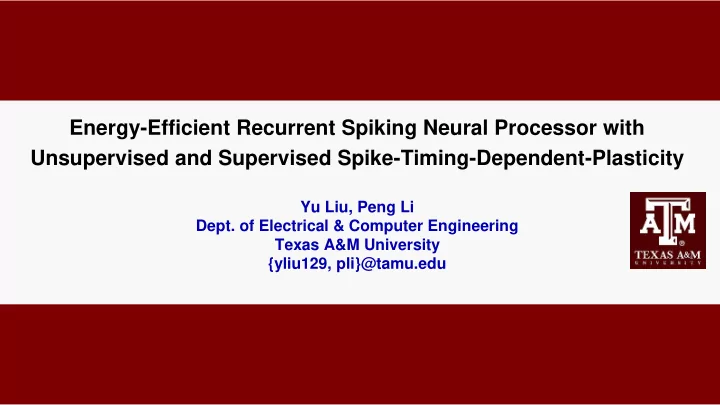

Energy-Efficient Recurrent Spiking Neural Processor with Unsupervised and Supervised Spike-Timing-Dependent-Plasticity Yu Liu, Peng Li Dept. of Electrical & Computer Engineering Texas A&M University {yliu129, pli}@tamu.edu
Neuromorphic Computing based on Spiking Neural Nets Spiking Neural Networks (SNNs) – Biologically realistic – Rate and temporal codes – Ultra-low energy, event-driven processing Present Challenges – Cognitive Principles: Rich inspiring ideas, limited successfully demonstration in real-world tasks – Network Architecture: Mostly simple networks such as feedforward – Training Locality constraints: algorithms for ANNs does not satisfy Lack of powerful spike-based training methods 2 Liu and Li. Energy-Efficient Recurrent Spiking Neural Processor with Unsupervised and Supervised Spike-Timing-Dependent-Plasticity
(Spiking) Liquid State Machine (LSM) Tradeoffs between biological plausibility, design complexity and performance. Recurrent reservoir structure Input Layer Reservoir Readout Layer Generally fixed Trainable for classification 3 Liu and Li. Energy-Efficient Recurrent Spiking Neural Processor with Unsupervised and Supervised Spike-Timing-Dependent-Plasticity
In This Work: Improve learning performance of LSM neural accelerators with power efficiency with proposed unsupervised and supervised STDP training algorithms. Supervised STDP Unsupervised STDP Reservoir training Readout training Supplement to classification training on Maximize the distance of firing frequency readout between desired and undesired neurons Sparse synaptic connectivity from self- Sparse synaptic connectivity without organizing reservoir tuning degrading performance Jin, Yingyezhe, and Peng Li. "Calcium-modulated supervised spike-timing-dependent plasticity for readout training and sparsification of the liquid state machine." Neural Networks (IJCNN), 2017 International Joint Conference on. IEEE, 2017. 4 Liu and Li. Energy-Efficient Recurrent Spiking Neural Processor with Unsupervised and Supervised Spike-Timing-Dependent-Plasticity
Spike-Timing-Dependent Plasticity (STDP) Reservoir Training Adjust the connection strengths based on the relative timing of spike pairs [Bi & Poo, Ann. review of neurosci.’01] 2 pre 1.5 w post ij − ∆𝑢 ∆𝑥 + = 𝐵 + 𝑥 ∙ 𝑓 𝜐 + 𝑗𝑔 ∆𝑢 > 0 1 pre w post − ∆𝑢 LTP 0.5 ∆𝑥 − = 𝐵 − 𝑥 ∙ 𝑓 𝜐 − 𝑗𝑔 ∆𝑢 < 0 t 0 LTD -0.5 Locally tune the synaptic weights -1 -30 -20 -10 0 10 20 30 Naturally lead to sparse t (ms) Jin, Yingyezhe, Yu Liu, and Peng Li. "SSO-LSM: A sparse and self-organizing architecture for liquid state machine based neural processors." Nanoscale Architectures (NANOARCH), 2016 IEEE/ACM International Symposium on. IEEE, 2016. 5 Liu and Li. Energy-Efficient Recurrent Spiking Neural Processor with Unsupervised and Supervised Spike-Timing-Dependent-Plasticity
Supervised STDP Readout Training CAL-S 2 TDP: Calcium-modulated Learning Algorithm Based on STDP – Supervisory signal (CT) combined with depressive STDP – Improving memory retention: Probabilistic weight update – Preventing weight saturation: Calcium-modulated stop learning 𝑥 ← 𝑥 + 𝑒 w/ prob . ∝ |∆𝑥 + |, 𝑗𝑔 ∆𝑢 > 0 && 𝑑 𝜄 < c < 𝑑 𝜄 + 𝜀 𝑥 ← 𝑥 − 𝑒 w/ prob . ∝ |∆𝑥 − |, 𝑗𝑔 ∆𝑢 < 0 && 𝑑 𝜄 − 𝜀 < c < 𝑑 𝜄 6 Liu and Li. Energy-Efficient Recurrent Spiking Neural Processor with Unsupervised and Supervised Spike-Timing-Dependent-Plasticity
Supervised STDP Readout Training CAS-S 2 TDP: Calcium-modulated Sparsification Algorithm Based on STDP – Fully connected readout synapses • Overfitting • Large hardware overhead – Random dropouts lead to significant performance drop . – Embed class information into to maximize the sparsity and secure learning performance. 𝑥 ← 𝑥 + 𝑒 w/ prob. ∝ | ∆𝑥 + |, 𝑗𝑔 ∆𝑢 > 0 && c < 𝑑 𝜄 + 𝜀 𝑥 ← 𝑥 − 𝑒 w/ prob. ∝ | ∆𝑥 − |, 𝑗𝑔 ∆𝑢 < 0 && 𝑑 𝜄 − 𝜀 < c 7 Liu and Li. Energy-Efficient Recurrent Spiking Neural Processor with Unsupervised and Supervised Spike-Timing-Dependent-Plasticity
Results Adopted Benchmark: – TI46 speech of English letters (single speaker, 260 samples) Training Settings – 5-fold cross-validation, 500 training iterations on readout layer – Baseline is a competitive spike-dependent non-STDP supervised training algorithm*. Baseline Proposed 92.3 ± 0.4% 9 3.8 ± 0.5% 135 Reservoir Inference Accuracy Neurons 89.6 ± 0.5% 92.3 ± 0.4% 90 Reservoir Neurons * Yong Zhang, Peng Li, Yingyezhe Jin, and Yoonsuck Choe, “A digital liquid state machine with biologically inspired learning and its application to speech recognition,” IEEE Trans. on Neural Networks and Learning Systems, Nov. 2015. 8 Liu and Li. Energy-Efficient Recurrent Spiking Neural Processor with Unsupervised and Supervised Spike-Timing-Dependent-Plasticity
Acknowledgement We thank High Performance Research Computing (HPRC) at Texas A&M University for providing computing support. Resource Utilization: – Cluster : Terra – Software : CUDA – Core & Memory : 1 GPU, 2GB – Typical Runtime : 0.5 ~ 2 days This material is based upon work supported by the National Science Foundation under Grant No. 1639995 and the Semiconductor Research Corporation(SRC) under task # 2692.001. 9 Liu and Li. Energy-Efficient Recurrent Spiking Neural Processor with Unsupervised and Supervised Spike-Timing-Dependent-Plasticity
Recommend
More recommend